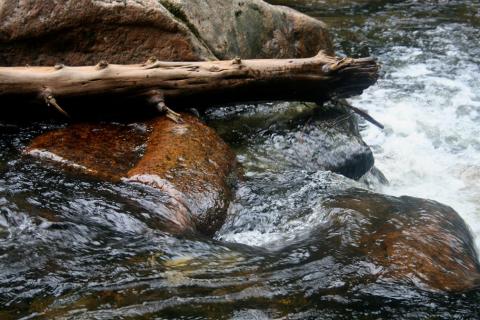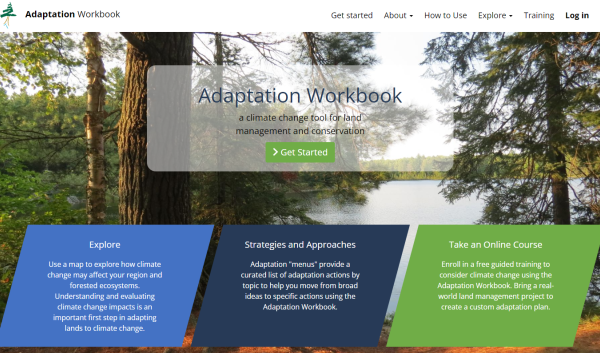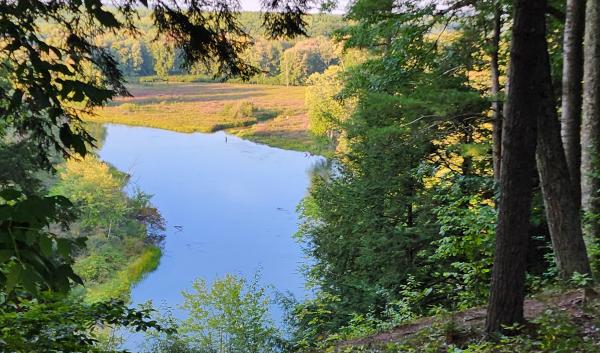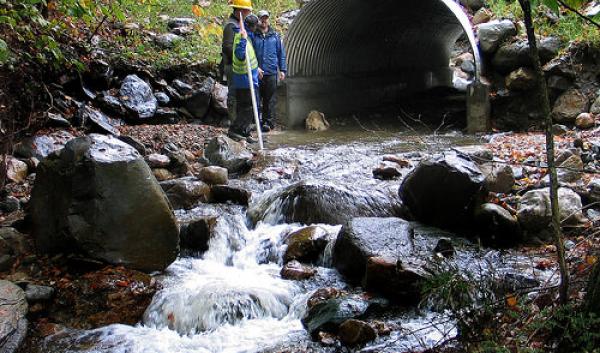Taking action now can help forested watersheds prepare for and adapt to a changing climate.
Forested watersheds improve water quality and enhance water storage, naturally regulate streamflows, reduce flood damages and stormwater runoff, replenish groundwater and provide a myriad of other benefits. Significant changes in temperature and precipitation present challenges to ensuring long-term ecosystem health, particularly in sensitive and unique riparian areas, and may amplify existing challenges related to infrastructure, stormwater, and water quality and quantity.

Effects from Climate Change
Climate change will not affect all parts of a watershed in the same way. The local response and vulnerability of a watershed to regional climate changes will be influenced by soils, topography, forest management, and current and past land uses. Warmer temperatures and variable precipitation will have direct impacts on the water budget and the hydrology of forested watersheds; affecting the timing, distribution and seasonal availability of precipitation. Forest ecosystem vulnerability assessments can help managers characterize site vulnerability in forested watersheds. Understanding the potential interactions of climate changes on the physical, biological, and social environment is critical to ensuring natural resources management reflects future conditions.
Adaptation in Action
Adaptation is critical to sustaining forests and water resources that people, animals, and plants depend upon. Northern Institute for Applied Climate Science has collaborated with partners to create adaptation resources that include hydrologic themes relevant to ecosystem-based management. The forested watersheds menu of adaptation strategies and approaches was designed for managers working in forests, riparian areas, floodplains, forested wetlands, and lakesheds. The adaptation menu is helpful to managers who are interested in supporting hydrologic functions and accommodating hydrologic changes, including issues related to facilities and infrastructure.
The Forested Watersheds Adaptation menu is designed to be used as a stand-alone resource, and it can also be used to supplement structured adaptation planning with the Adaptation Workbook process (published in Forest Adaptation Resources: Climate Change Tools and Approaches for Land Managers).

Strategies and approaches
The 6 strategies, 28 approaches, and 100+ example tactics were developed through an assessment of existing adaptation tools, focus group discussions, and workshops with natural resource professionals.
Adaptation strategies are very general and can be applied in many ways across different ecosystems and cultural contexts. Adaptation approaches are more specific, describing in greater detail how strategies could be put into practice.
These strategies and approaches are designed to serve as stepping stones to allow natural resource managers and planners to translate broad concepts into targeted and specific actions (tactics) for putting climate change adaptation into practice to achieve a specific management objective in a specific location.
Example tactics are provided in the menu as illustrations of a few of the possible actions that could implemented for climate adaptation.
Menu of Adaptation Strategies and Approaches Developed for Forested Watersheds
-
Approach 1.1: Maintain and enhance infiltration and water storage capacity of forest soils.
Approach 1.2: Maintain and restore hydrologic connectivity.
Approach 1.3: Maintain and restore stream channel form and function.
Approach 1.4: Maintain and restore floodplain connectivity.
Approach 1.5: Maintain and restore forested wetlands and lowland areas.
-
Approach 2.1: Moderate surface water temperature increases.
Approach 2.2: Reduce export and loading of nutrients and other pollutants.
Approach 2.3: Reduce soil erosion and sediment deposition.
-
Approach 3.1: Maintain or restore forest and vegetative cover in riparian areas.
Approach 3.2: Promptly revegetate areas after disturbance.
Approach 3.3: Maintain or improve the ability of forests to resist pests and pathogens.
Approach 3.4: Prevent invasive species establishment and remove existing invasive species.
Approach 3.5: Prioritize and maintain unique habitats for refugia.
Approach 3.6: Enhance species age classes and structural diversity in forests.
Approach 3.7: Identify, maintain, and enhance important habitats for fish and wildlife.
-
Approach 4.1: Favor or restore native species that are expected to be adapted to future conditions.
Approach 4.2: Establish or encourage new mixes of native species.
Approach 4.3: Disfavor species that are distinctly maladapted.
Approach 4.4: Introduce species that are expected to be adapted to future conditions.
Approach 4.5: Move at-risk species to locations that are expected to provide habitat.
-
Approach 5.1: Manage systems to cope with decreased water levels and limited water availability.
Approach 5.2: Enhance the ability of systems to retain water.
Approach 5.3: Adjust systems to cope with increased water abundance, and high water levels.
Approach 5.4: Respond to or prepare for excessive overland flows (surface runoff).
-
Approach 6.1: Reinforce infrastructure to meet expected conditions.
Approach 6.2: Reroute or relocate infrastructure, or use temporary structures.
Approach 6.3: Incorporate natural or low impact development into designs.
Approach 6.4: Remove infrastructure and readjust system.
Citation
Shannon, P. Danielle, Christopher W. Swanston, Maria K. Janowiak, Stephen D. Handler, Kristen M. Schmitt, Leslie A. Brandt, Patricia R. Butler-Leopold, and Todd Ontl. 2019. "Adaptation strategies and approaches for forested watersheds." Climate services, 13, 51-64 https://doi.org/10.1016/j.cliser.2019.01.005
Acknowledgements
The Northern Institute for Applied Climate Science and regional partners led the development of the forest adaptation strategies and approaches, which can be used with the Adaptation Workbook process (published in Forest Adaptation Resources: Climate Change Tools and Approaches for Land Managers). The Northern Institute of Applied Climate Science (NIACS) a collaborative, multi-institutional partnership led and supported by the USDA Forest Service.




